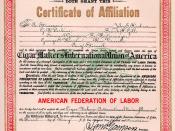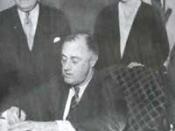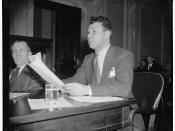IntroductionMost workers today are able to seek out and select jobs that are acceptable to them, especially when there is such stiff competition for good employees who have skills that are hard to replace. Workers are able to negotiate pay, benefits, hours, as well as many other working conditions. However, on occasion there are instances where workers believe their needs and/or interests are not being considered or met by management. In these instances, some workers respond by acting collectively and forming or joining labor unions to represent their interests and resolve conflicts with the employers. (Noe, Hollenbeck, Gerhert, Wright, 2003) The formation of unions creates an environment where organizations need to maintain a labor relations strategy to help align employee interests with that of his or her employers.
Labor UnionsA union is defined as an organization formed for the purpose of representing the member's interests when dealing with employers. (Noe, Hollenbeck, Gerhert, Wright, 2003) Unionism dates back to the founding days of our country and early attempts to organize workers in 1869.
The American Federation of Labor (AFL) was founded in 1886 and it gave many employees their first experience with strong organized unions. (Noe, Hollenbeck, Gerhert, Wright, 2003)From the 1930s to 1950s significant laws and regulations regarding unions were promulgated. The Wagner Act, more commonly known as the National Labor Relations Act (NLRA), was passed in 1935. It guaranteed employees broad rights to organize and bargain collectively. Labor relations legislation passed in the 1940s and 1950s (specifically the Taft-Hartley Act in 1947) placed further regulations on the collective bargaining relationship. This also attempted to balance the interests of labor and management. Union membership continued to grow and peaked in the 1950s reaching over one-third of U.S. employees. (Noe, Hollenbeck, Gerhert, Wright, 2003)In the 1950s union membership began to decline.



Labor Relations
This essay purports to be a discussion of unions, but it lists as its only source a book on "human relations," a topic that very often becomes a discussion of strategies for avoiding unions. Unfortunately, the text of the essay reflects the bias of the source.
2 out of 2 people found this comment useful.